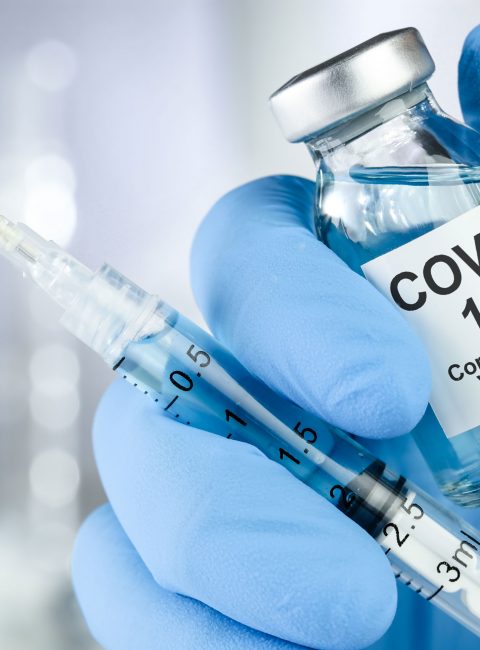 >
Spotlight February 2021: Nanoobjects in the COVID-vaccine – scientifically correct?
>
Spotlight February 2021: Nanoobjects in the COVID-vaccine – scientifically correct?
The COVID-19 pandemic induces very different reactions of people on the internet (https://www.cdc.gov/mmwr/volumes/70/wr/mm7002e1.htm) and in the social networks. Without following the conspiracy theories as “5G nanochip hidden in COVID vaccines” some news as “COVID vaccines induce allergic reactions” should be scientifically recognised. The picture from the 5G-nanochip whose plan goes viral on the internet is now exposed as fake and shows a guitar pedal. Quite different the recent news about allergic responses after injection of the COVID vaccine [1-3]. Is it true, and how about nanoparticles in vaccines?
Firstly, we should know that the active ingredient within the new vaccines are very sensitive molecules (the so-called mRNA) which must not only be cooled during transport but also would immediately be degraded after injection if not explicitly be stabilized by a special nano-shell. Here the principles of nanomedicine are adopted as the instable RNA-molecule is packed into a lipid layer containing stabilizing polymers (e.g. polyethylene glycol = PEG and others) [4, 5]. These polymers are part of the transport system which delivers the active agent to the cells in our body which start the anti-viral machinery. Unfortunately, such molecules may have a disadvantage because a small part of the population responds sensitive to polymers such as PEG which has been observed in 12 patients after getting the vaccine [1, 3]. The portion of sensitive people is very small but not negligible (currently more than 32 Mio. people have been vasccinated, as of January 2021), thus, it is important to know about the ingredients [please find the full list of the two recent vaccines in 3] and to discuss these with the treating physician. Scientific fact is: the size of the lipid vesicles (nano) is not of importance in relation to adverse effects. Ingredients such as the polymers of the shell around the active agent may induce problems, but the advantage of a COVID vaccination is indisputable.
If someone wants to know more about nanoparticles and vaccination, please visit the website of the Helmholtz Centre for Infection Research: https://www.helmholtz-hzi.de/en/news-events/stories/vaccination-with-nanoparticles/ .
Literature:
- de Vrieze, J (2021) Pfizer’s vaccine raises allergy concerns. Science, 371(6524): 10-11.
- Kleine-Tebbe, J et al. (2021) Severe allergic reactions to the COVID-19 vaccine – statement and practical consequences. Allergol Select, 5 26-28.
- Worm, M et al. (2021) Covid-19 vaccination and risk of anaphylaxis – Recommendations for practical management. MMW Fortschr Med, 163(1): 48-51.
- Editorial (2020) Nanomedicine and the COVID-19 vaccines. Nat Nanotechnol, 15(12): 963
- Abd Ellah, NH et al. (2020) Nanomedicine as a promising approach for diagnosis, treatment and prophylaxis against COVID-19. Nanomedicine (Lond), 15(21): 2085-2102.

Weitere Spotlights
Spotlight October 2022: The titanium dioxide debate – why the current ECHA and EFSA hazard classification should be questioned
Due to various reports and scientific studies, titanium dioxide (TiO2)was also banned in Europe this year (2022) for use as a food additive with the indication that it could possibly be carcinogenic to humans. Although no case of tumour induction in humans has been reported since the use of this material in micro but also […]
Read moreSpotlight July 2022: New definition on nanomaterials published
The European Union has published a new definition for nanomaterials as of June 2022. It is recommended that this be used as a basis for future legislation. The new documents can be found on the EC website. In the new “nanodefinition”, the essential components such as the origin or the size range of the particles […]
Read moreSpotlight March 2022: Safe Materials from Scratch – Safe-by-Design-Concept in action
In recent decades, German research on nanomaterials and new, innovative materials has been widely expanded by material safety aspects. European initiatives also pay significant attention to this: both the European Union (EU) Green Deal, and the Chemicals Strategy for Sustainability (CSS) aim to create a sustainable, climate-neutral economy with sustainable and safe chemicals and products, […]
Read moreSpotlight August 2023: From principles to reality. FAIR implementation in the nanosafety community
In the August 2023 Spotlight, we present a paper that addresses the implementation of FAIR (Findability, Accessibility, Interoperability and Reusability) Data in nanosafety research. The authors introduce the new AdvancedNano GO FAIR Implementation Network (see also https://www.go-fair.org/implementation-networks/overview/advancednano/) established as part of the GO FAIR initiative. The paper highlights the AdvancedNano GO FAIR Implementation Network’s support […]
Read more


